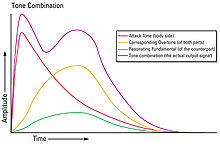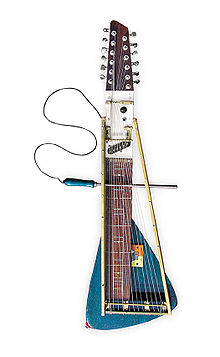- Moodswinger
-
The Moodswinger is a twelve string electric zither with an additional third bridge designed by Yuri Landman. The rod which functions as the third bridge divides the strings into two sections to cause an overtone multiphonic sound. One of the copies of the instrument is part of the collection of the Musical Instrument Museum in Phoenix, AZ.
Contents
History
In March 2006 Landman was contacted by the noise band Liars to make an instrument for them. After 6 months he finished 2 copies of The Moodswinger, an electric 12 string 3rd bridge overtone koto, one for guitarist/drummer Aaron Hemphill and one for himself.[1] Although it closely resembles an electric guitar, it is actually a zither, as it has neither frets nor a proper neck. The pickup and electronics are built into the neck instead of in the body like usual electric guitars. After Liars received their Moodswinger, they started recording their fourth album Liars. The song Leather Prowler is played with the Moodswinger,[2] in many reviews confused with a piano.[3] In 2008 the Moodswinger II was released as a serial product. Jessie Stein of The Luyas owns a copy.
In 2009 Landman created a derivative version of the instrument called the Home Swinger, for workshops at festivals, where participants built their own copy within four hours. In 2010 the Musical Instrument Museum in Phoenix included a Moodswinger as well as a Home Swinger in their collection as two of the pieces of the Dutch section of musical instrument inventions.
Physical background
 Tone combination[4]
Tone combination[4]
The 3rd bridge divides the strings into two segments with different pitches. Depending on where the string is played, a bell-like harmonic second tone is created. The string resonates more or less when the back side is struck, depending on the position of the 3rd bridge along the string. This can be explained by acoustic resonance and microtonality. At harmonic nodal positions, the string resonates more than at other positions. For instance, dividing the string 1/3 + 2/3 creates a clear overtone, while 24/33 + 9/33 creates an indistinct overtone. The color dotted scale indicates the simple-number ratios up to the 7 limit (on the Moodswinger II to the 8 limit.) On these positions just intoned harmonic dyads occur.
Tuning and scales
The Moodswinger is focused on a non-atonal playing technique. A mathematical scale is added to specify 23 harmonic positions on the strings. Because the instrument has 12 strings, tuned in a circle of fourths, it is always possible to play every note of the equal tempered scale. However some positions have a + or - indication, because the equal tempered scale is not a perfect well-tempered scale.[5]
The tuning of this instrument is a circle of fourths: E-A-D-G-C-F-A#-D#-G#-C#-F#-B, arranged in 3 clusters of 4 strings each to make the field of strings better readable.
Because of this tuning all five neighbouring strings form a harmonic pentatonic scale and all seven neighbouring strings form a major scale, available in every key. This allows a very easy fingerpicking technique without picking false notes, if the right key is chosen.
 Moodswinger scale, based on overtone positions
Moodswinger scale, based on overtone positions
The instrument has 3 printed scales, used as guides for positioning the moveable third bridge and reading the played notes:
- The normal guitar (equal-tempered) scale
- An inverse scale (large steps between the frets at the top of the neck, small ones at the body bridge)
- A microtonal scale which shows "logical" string divisions in the following color-coded groups:
- Grey dot: 1/2
- Red dot: 1/3+2/3
- Orange dot: 1/4+3/4
- Yellow dot: 1/5-4/5
- Green dot: 1/6+5/6
- Cyan dot: 1/7-6/7
- And a smaller subscale for the higher-pitched overtones near the body bridge in colored lines:
- Grey line: 1/8
- Red line: 1/9
- Orange line: 1/10
- Yellow line: 1/11
- Green line: 1/12
- Blue line: 1/16
On the Moodswinger II the 1/8, 3/8, 5/8 and 7/8 are Blue dotted. On the Home Swinger the same color system occurs.
Moodswinger overtone diagram
The sound of a 3rd bridged string is a combination of 3 tones. A soft sounding attack tone of the string part hit at the body side, the corresponding overtone of both sides and a resonating low fundamenal tone of the counterpart of the string at the head side. The diagram below shows the tone combinations of the overtone (above) and the low tone of the counterpart (below). The attack tone is in most positions exact the same note as the overtone. Exceptions are 3/4, 3/5, 3/7 and 5/7. In the 3/... positions the overtone is a perfect fifth of the attack tone, in the 5/7 positions the overtone is a major third of the attack tone.
Bridge position Colour codes Attack tone related to open string[6]
Resonating fundamental of the counterpart [6] related to open string
Corresponding overtone related to open string
Corresponding overtone related to fundamental of the counterpart
Cents of string parts[7]
Body : Neck
0 Unison Unison 1/16 Grey line 4 Octaves Diatonic semitone 4 Octaves Augmented fourth 21ma 111.73 : 4800.001/12 Green line Just Perfect fifth 21ma Lesser undecimal neutral second Just Perfect fifth 21ma Just Perfect fourth 21ma 150.64 : 4302.001/11 Yellow line Greater septimal tritone 21 ma Greater undecimal neutral second Greater septimal tritone 21 ma Just major third 21ma 165.00 : 4151.301/10 Orange line Just major third 21ma Just minor tone Just major third 21ma Just minor tone 21ma 182.40 : 3986.301/9 Red line Just minor tone 21ma Major second or Just minor tone Just minor tone 21ma 3 Octaves 203.91 : 3803.901/8 Grey line 3 Octaves Diminished third 3 Octaves Just Major sixth 15ma 203.91 : 3600.001/7 Blue dot Augmented sixth 15ma Septimal minor third Augmented sixth 15ma Just Perfect fifth 15ma 266.87 : 3368.801/6 Green dot Just perfect fifth 15ma Just minor third Just perfect fifth 15ma Just major third 15ma 315.64 : 3102.001/5 Yellow dot Just major third 15ma Just major third Just major third 15ma 2 Octaves 386.31 : 2786.301/4 Orange dot Fifteenth Just perfect fourth Fifteenth Twelfth 498.04 : 2400.002/7 Blue dot Augmented sixth 8va Augmented fourth or tritone Augmented sixth 15ma Just major third 15ma 582.51 : 1782.511/3 Red dot Twelfth Just perfect fifth Twelfth Octave 701.96 : 1901.962/5 Yellow dot Just major third 8va Just major sixth Just major third 15ma Just Perfect fifth 8va 884.36 : 1586.313/7 Blue dot Septimal minor third 8va Augmented sixth Augmented sixth 15ma 2 Octaves 968.83 :1466.871/2 Grey dot Octave Octave Octave Unison 1200.00 :1200.004/7 Blue dot Augmented sixth Septimal minor third 8va Augmented sixth 15ma Just Perfect fifth 8va 1466.87 : 968.833/5 Yellow dot Just major sixth Just major third 8va Just major third 15ma Octave 1586.31 : 884.362/3 Red dot Just perfect fifth Twelfth Twelfth Unison 1901.96 : 701.965/7 Blue dot Augmented fourth or tritone Augmented sixth 8va Augmented sixth 15ma Octave 1782.51 : 582.513/4 Orange dot Just perfect fourth Fifteenth or 2 Octaves Fifteenth Unison 2400.00 : 498.044/5 Yellow dot Just major third Just major third 15ma Just major third 15ma Unison 2786.30 : 386.315/6 Green dot Just minor third Just Perfect fifth 15ma Just Perfect fifth 15ma Unison 3102.00 : 315.646/7 Blue dot Septimal minor third Augmented sixth 15ma Augmented sixth 15ma Unison 3368.80 : 266.87References
- ^ Article on modernguitars.com
- ^ [1] Pitchfork Media interview with Yuri Landman
- ^ [2][3][4][5][6] 5 reviews which describe the sound of a piano.
- ^ http://id.mind.net/~zona/mstm/physics/waves/interference/ waveInterference1/WaveInterference1.html
- ^ BAIN: The Harmonic Series (Overtone Series)
- ^ a b http://www.xs4all.nl/~huygensf/doc/intervals.html List of interval names in English
- ^ BAIN ATMI 2002: Cents/RatioToCents Appl
External links
- Moodswinger on hypercustom.com
Instrument intonation Just intonation in any key Dynamic intonation adjustment Just intonation in one key Retunable to a just key Flageolet tones or
natural overtone seriesPhysical just-intoned string
part relation with additional 3rd bridgeCategories:- Custom-made instruments
- Experimental musical instruments
- Experimental string instruments
- Zithers
Wikimedia Foundation. 2010.




